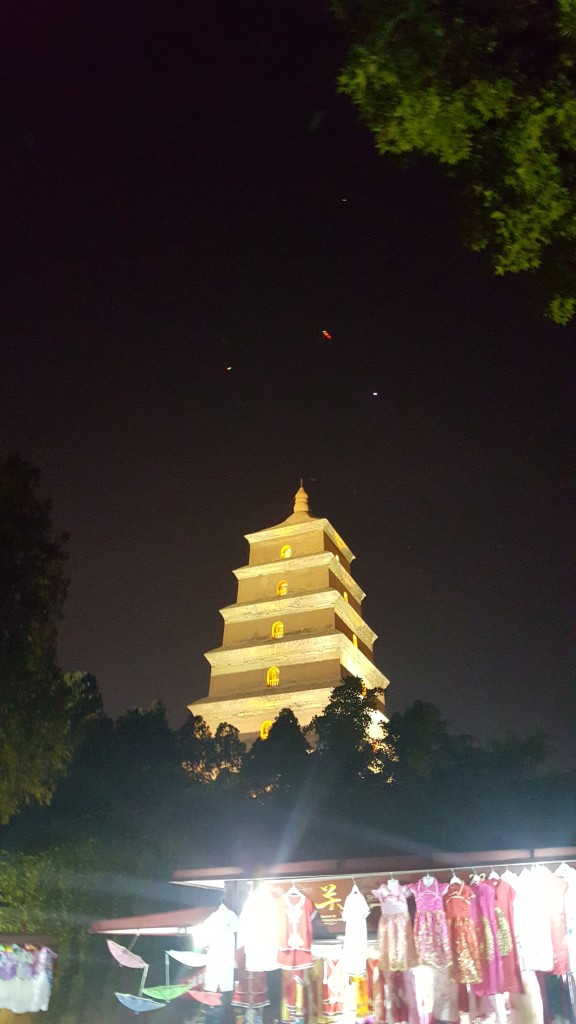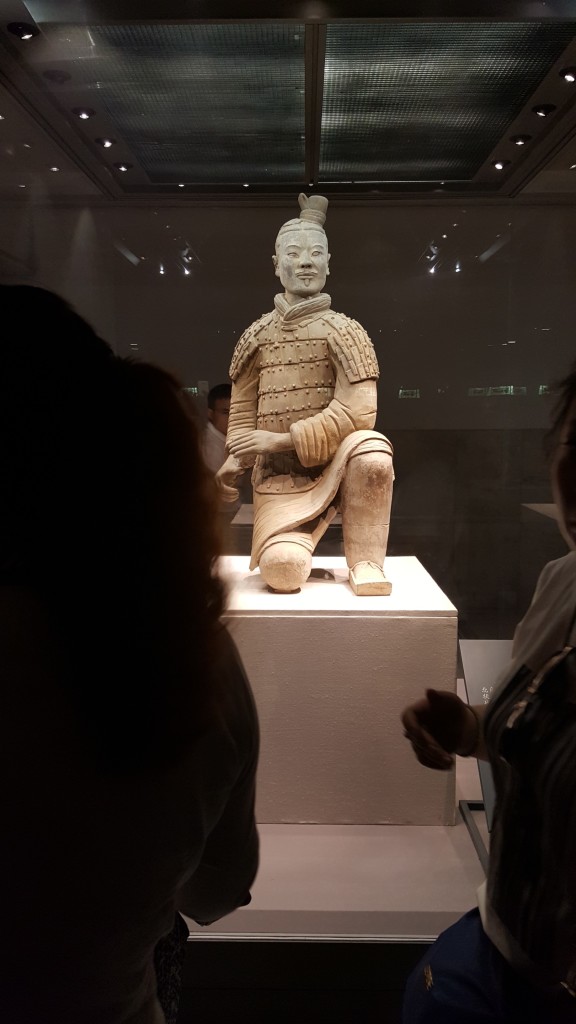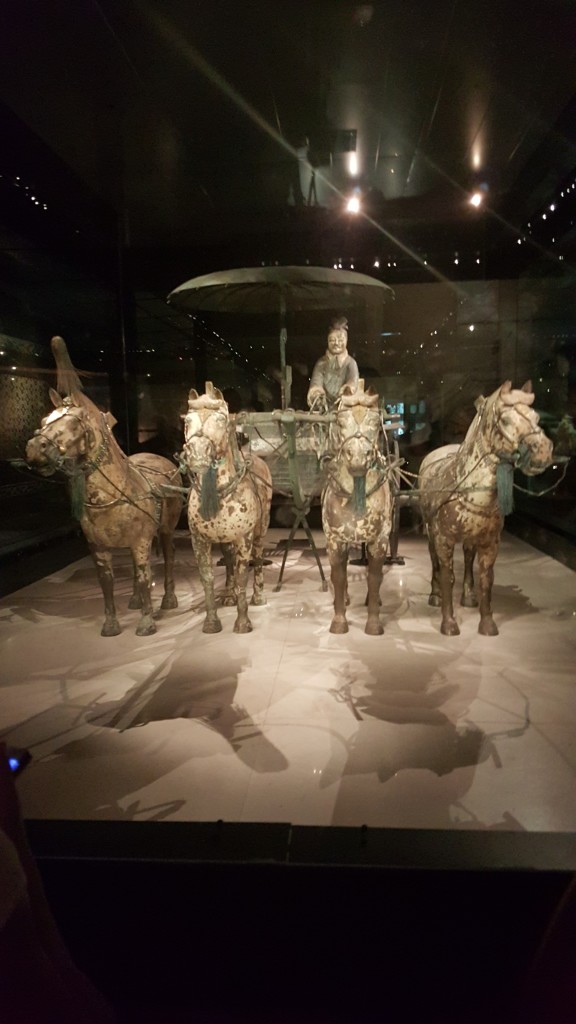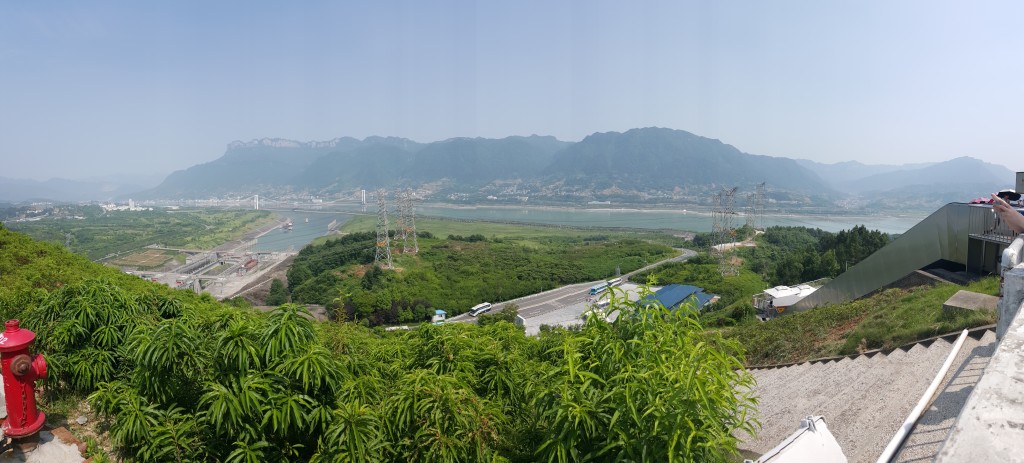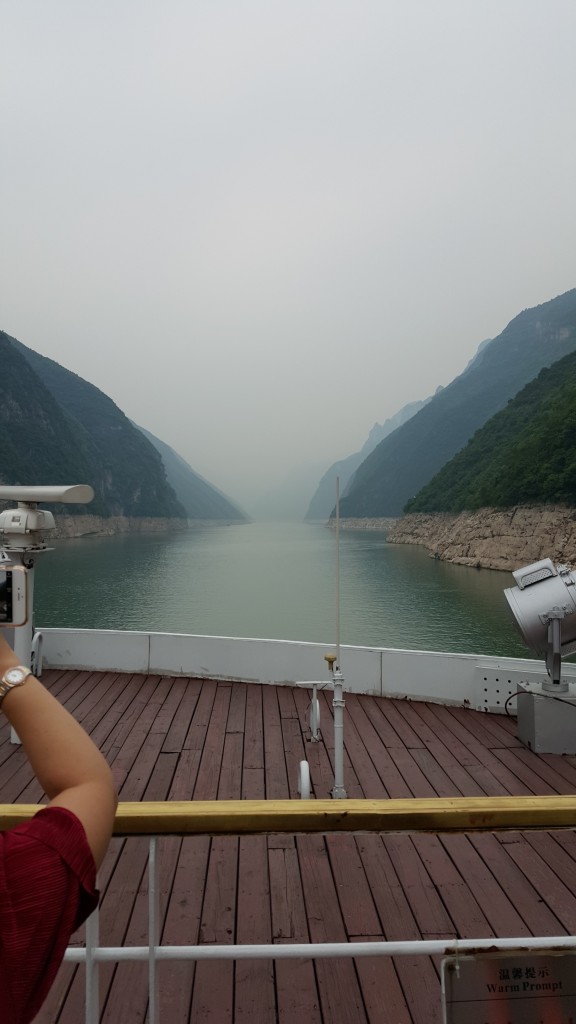Over the next week, we visited the historical city of Xian and had a more relaxing week aboard a cruise.
(5/18) When we arrived in Xian, we boarded a bus and went to see the Bell Tower and the Drum Tower. We then went to dinner at a theater that had a huge buffet on the second floor (there were french fries here and this had everyone jumping for joy). After dinner, we went to see the Big Wild Goose Pagoda.
We got to go to see the City Fountain. There was a light and music fountain show. It was really neat. There were so many people there watching and a lot of other tourists too.
After seeing the fountain, we headed back to our hotel to check in. The city of Xian is sorrounded by a city wall so it is set up like a grid. There is a North, East, South, and West side. Our hotel was in the middle of the city so there was a great view from my room.
The next morning, after eating breakfast, we went to see the terracotta warriors.
It was amazing. I really wish we could have seen the tomb that the warriors were built to protect, but there is a mercury river running through it, so they don’t know if that will ever be able to open to the public. There were three major pits that we saw. The excavation process was not done in any of them, but they went from most to least excavated. The number of soldiers and the amount of area that the army covered amazed me. The tunnel system they were built in was crazy. It was hard to believe that this was achieved so long ago and only so recently discovered. We visited the site of the terracotta warriors for about 3 hours.
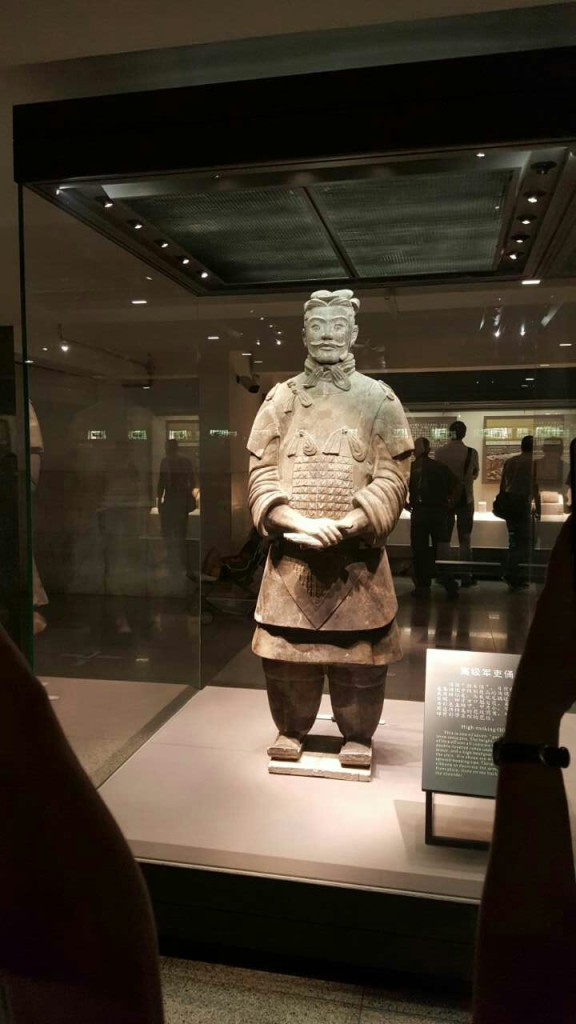
This is a general. There is more detail in his clothing and all the generals have a similar gestures with their arms and hands.
When we were done viewing the warriors, we went to eat and I got some Biang Biang noodles. I learned about them last year in my Chinese class and was so excited to eat them. They were really good and watching them being made was really entertaining. They stretched them out really long and then twisted them and pulled them together.
After lunch, we got to visit the city wall. Me and Ting rented a tandem bicycle and we cycled the 9 miles of the wall. We could see the city all around us as we rode. It was really awesome, but it was made from bricks, so when we finished riding our butts hurt so badly!

The city wall on the outside of what used to be the ancient city of Xian. The city now surrounds area well beyond the outside of the wall.
After visiting the city wall, we went to Muslin Street. Muslin Street had a lot of street food and cool shops. I ate lamb for the first time and I was with Nate, who kept talking about anthrax which was comforting. After that, Xinli ordered us a bunch of “juicy dumplings” and I ate until I was full. I then went and bought a few gifts along the street.
After we visited the street, we went back to our hotel and just hung out for the night because we had to wake up at 6 a.m. to catch our train to Yichang.
–
(5/20) Yesterday we were on the sleeper train all day. I slept a decent amount of the trip because I was not feeling well. Since we all eat from the same plates, it is very easy for sicknesses to pass from one person to the next. Almost half of our group is/has gotten sick the past week.
On the train ride, other than sleeping, I watched a couple of movies and ate some food and just hung out and talked. The train ride was 14 hours long, so we had a lot of time to kill. When we arrived at Yichang from Xian, we were picked up by a bus. We then went to the port and got onto our cruise ship. The cruise ship is huge. It is 6 stories and it has a deck on both sides and balconies for every room. This is my first time on a cruise and I am able to confirm that I do not get sea sick. There is a buffet at every meal so I have been eating a lot. I didn’t eat a lot in Beijing, so I am just making up for that now.
We went and visited the Three Gorges Dam Thursday afternoon. It is the biggest hydroelectric plant in the world. The dam is gigantic. There were huge turbines, 46 of them in total, generating the electricity.
The tour guide explained to us that the dam was built to end devastating floods in the area. In China, the government owns all property, so when they wanted to build the dam in this location, all residents currently living here were relocated. He said that many people in the older generation were very reluctant to move, because this is where their family had lived for generations. However, the younger generation was more willing to move, because they knew that in the cities there was opportunity to make a better life for their families.
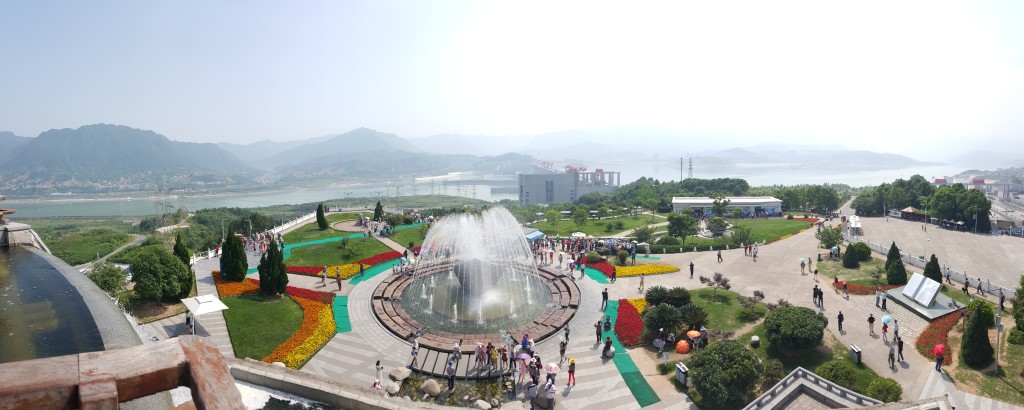
This was taken from the highest point above Three Gorges Dam. It was a beautiful, but extremely hot, day.
We explored Three Gorges Dam for about an hour and a half and then returned to the boat. We then were welcomed by the captain at a cocktail party. After the captain and his crew were introduced, they started playing music, but no one was on the dance floor. A bunch of us ran onto the dance floor. We were having a good time, and almost the entire room was watching us. There were a few people who joined us and there was even some very good dancing happening between Steve and an older Chinese man. He was getting as low to the ground as Steve. I was really impressed.
After dancing and some dinner, we hung out on the deck until midnight. At midnight we reached the ship lock. We went into the ship lock with two other boats and the gates closed behind us.
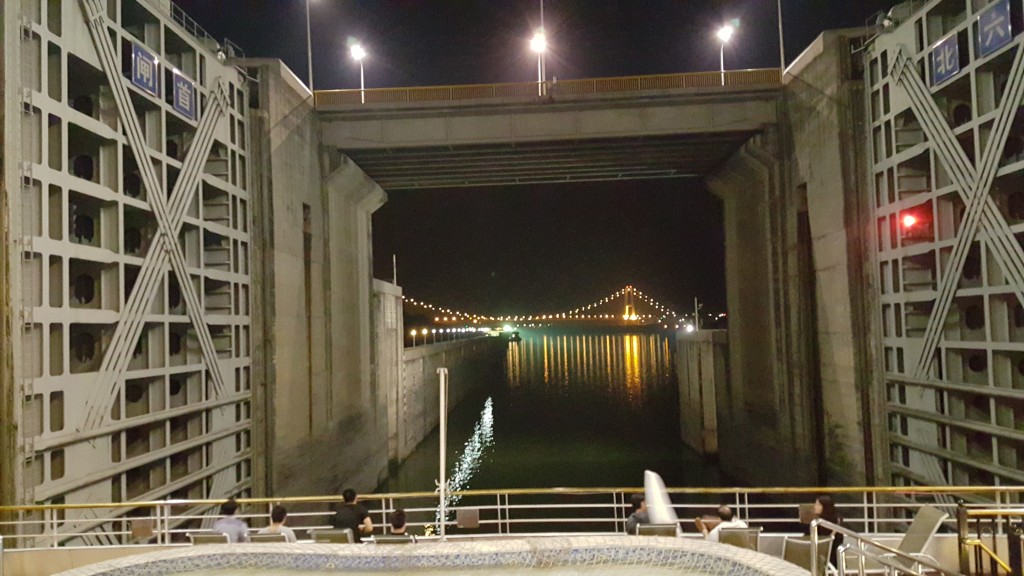
The doors of the ship lock in the process of closing. I actually was able to touch the side of the canal we were that close as the water level rose!
The water from the channel we were in and the channel ahead of us started to level out. Once the water from each channel was in equilibrium, we moved on to the next channel to repeat the process. I am not sure how long it took us to get through the ship lock, but the crew said it would probably take about 4 hours. I went to bed when we got to the second lock.
In the morning, we boarded onto a smaller ship and explored the Lesser Three Gorges while our boat was cleaned. The Lesser Three Gorges looked like the Grand Canyon except they had a lot more trees growing alongside the cliffs. The water was fairly deep here and took around an hour and a half to go from the beginning to the end, but at the end we had to turn around and come back, so it took about 3 hours total. We were allowed to stand on the deck of the boat and instead of whale watching, we were monkey watching. There were a lot of tiny monkeys climbing the cliffside. They were really fun to watch and I was amazed that they could climb along the rocky cliff. When we got back on our boat we just hung out for the night. We got Wi-Fi for the first time in four days, but it did not work very well, so I just gave up. I went to bed pretty early because I got really sick, and when I woke up, I had lost my voice!
I didn’t talk much the next day…mostly because I couldn’t. We went to see the Ghost City in Fengdu. We had to climb up a mountain so it was a lot of work. There were tests along the way so the people protecting the mountain could decide if we were good or bad and whether or not we would be sent to heaven or hell. We got to see the temple of heaven and hell. The temples were used for Taoist prayer or Buddhist prayer, depending on the design and decorations. There was a temple of 100 babies and our tour guide said the local people go there to pray that their child will be healthy before it is born.
When we were in the temple of hell, there were a lot of figurines depicting very disturbing forms of torture. When the temple was built they wanted to scare people so they would not be bad, and this was one way that they did it.
We then enjoyed the view at the top of the mountain and climbed back down to get back to our boat. When we were towards the bottom I went to talk to some of the people selling items at stands they had set up. I learned that they spoke a different dialect. They were trying to sell me beer and I tried telling them I don’t drink beer, but they shook their head no. I told them I really didn’t drink it and they laughed because the way I said drink was different from the way they said drink. Instead of saying he, they say ke. So I was saying a completely different word to them, and it must have been funny. It surprises me how much the language can change in just 100 miles. At our previous stop, they also said a lot of words differently. I know that most native Chinese speakers can understand each other even through the dialects, but for me, I am not as flexible with my Chinese so it is more difficult to understand and pick up on these nuances.

How I went about drying my clothes. I was definitely afraid of them falling overboard, so I secured everything as much as I possibly could.
Location: The Yangtze, China


